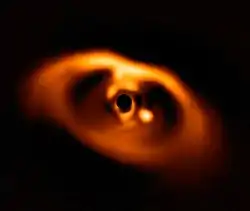Kepler-1625b I
Kepler 1625b I, a possible moon of exoplanet Kepler-1625b, may be the first exomoon ever discovered (pending confirmation), and was first indicated after preliminary observations by the Kepler Space Telescope.[4] A more thorough observing campaign by the Hubble Space Telescope took place in October 2017, ultimately leading to a discovery paper published in "Science Advances" in early October 2018. Studies related to the discovery of this moon suggest that the host exoplanet is up to several Jupiter masses in size, and the moon is thought to be approximately the mass of Neptune. There is a possibility that the large exomoon may have a moon itself, called a subsatellite.[5] Kepler-1625b I may be habitable, considering the host planet has an equilibrium temperature of 253 K (−20 °C; −4 °F).[3][1][2][6][7]

| Discovery[1] | |
|---|---|
| Discovered by | Alex Teachey, David M. Kipping and Allan R. Schmitt |
| Discovery date | 2017 |
| Primary transit | |
| Orbital characteristics | |
| 45 RKepler-1625b | |
| Satellite of | Kepler-1625b |
| Physical characteristics | |
Mean radius | 0.437 RJ |
| Mass | 10 M⨁ 0.06 MJ[2] |
.tif.jpg.webp)
The original paper[1] presented two independent lines of evidence for the exomoon, a transit timing variation indicating a Neptune-mass moon, and a photometric dip indicating a Neptune-radius moon. An independent re-analysis of the observations published in February 2019[8] recovered both but suggested that an inclined and hidden hot-Jupiter could also be responsible, which could be tested with future Doppler spectroscopy radial velocity observations. A third study analyzing this data set recovered the transit timing variation signature but not the photometric dip, and thus questioned the exomoon hypothesis.[9] The original discovery team later addressed this paper, finding that their re-reduction exhibits higher systematics that may explain their differing conclusions.[10]
References
- Teachey, Alex; et al. (2018). "Evidence for a large exomoon orbiting Kepler-1625b". Science Advances. 4 (10): eaav1784. arXiv:1810.02362. Bibcode:2018SciA....4.1784T. doi:10.1126/sciadv.aav1784. PMC 6170104. PMID 30306135.
- "The Extrasolar Planet Encyclopaedia — Kepler-1625 b I".
- Chou, Felicia; Villard, Ray; Hawkes, Alison; Brown, Katherine (3 October 2018). "Astronomers Find First Evidence of Possible Moon Outside Our Solar System". NASA. Retrieved 5 October 2018.
- Teachey, A.; Kipping, D. M.; Schmitt, A. R. (26 July 2017). "HEK. VI. On the Dearth of Galilean Analogs in Kepler, and the Exomoon Candidate Kepler-1625b I". The Astronomical Journal (published January 2018). 155 (1). arXiv:1707.08563. Bibcode:2018AJ....155...36T. doi:10.3847/1538-3881/aa93f2.
- Forgan, Duncan (4 October 2018). "The habitable zone for Earthlike exomoons orbiting Kepler-1625b". arXiv:1810.02712v1 [astro-ph.EP].
- Drake, Nadia (3 October 2018). "Weird giant may be the first known alien moon - Evidence is mounting that a world the size of Neptune could be orbiting a giant planet far, far away". National Geographic Society. Retrieved 6 October 2018.
- "Hubble finds compelling evidence for a moon outside the Solar System - Neptune-sized moon orbits Jupiter-sized planet". SpaceTelescope.org. Retrieved 6 October 2018.
- Heller, Rene; Rodenbeck, Kai; Giovanni, Bruno (2019). "An alternative interpretation of the exomoon candidate signal in the combined Kepler and Hubble data of Kepler-1625". Astronomy and Astrophysics. 624: 95. arXiv:1902.06018. Bibcode:2019A&A...624A..95H. doi:10.1051/0004-6361/201834913.
- Kreidberg, Laura; Luger, Rodrigo; Bedell, Megan (24 April 2019). "No Evidence for Lunar Transit in New Analysis of HST Observations of the Kepler-1625 System". arXiv:1904.10618.
- Teachey, Alex; Kipping, David M.; Burke, Christopher (2019). "Loose Ends for the Exomoon Candidate Host Kepler-1625b". The Astronomical Journal. 159 (4): 142. arXiv:1904.11896. Bibcode:2020AJ....159..142T. doi:10.3847/1538-3881/ab7001.
